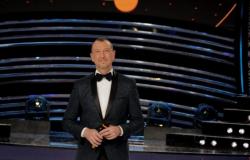Giuliano Vangi and Maurizio Pollini leave almost at the same time, with their lives completed. Their greatness was fostered, enhanced by their maturity. They made us see and hear with different eyes and ears, made aware by their interpretations. Because for Vangi, as for Pollini with respect to Mozart and Beethoven, it was a question of reinterpreting the great sculpture of Giovanni Pisano, Arnolfo di Cambio, Tino di Camaino, Jacopo della Quercia, Donatello, Michelozzo, Michelangelo. The study of ancient and medieval statuary, especially Tuscan, supports all his images. Pollini humbly said: «How can we know if we have understood the meaning of a piece of music? From the emotion it gives us. It is a subjective criterion, yet it is the only one that really works.” This is the meaning of an artist’s life: to make us understand.
Vangi was the last ancient, classical Italian sculptor. He conveyed emotions, physical and psychological, making us feel the strength and drama of our time. Franco Russoli had spoken for Vangi of «an idea of the modern human condition, understood as loneliness, anxiety, silent question without exhaustive answer». In front of his work we feel our loneliness. His conception of art is designed for us and for the world, in its infinite forms, as Pollini did with music.
Vangi has a large and accomplished museum of his work in Japan. On the side of a hill at the foot of Japan’s sacred volcano, Fuji, in a setting of beauty in Mishima, 100 kilometers southwest of Tokyo, the first museum in the world dedicated to a living sculptor. Among the outdoor works, three mega-installations: Stratification, in which a large seated figure, which seems to be formed by the sedimentation of layers, contemplates petrified trees six meters high, The man in the reeds, where a thread-like man emerges from a forest of reeds and notices the surrounding landscape with amazed and painful wonder, and La scala del Cielo, a work in two parts, one emerging and the other underground.
Strength and pain were the spirit of his art. Both contemporary and ancient, as is the history of man and his feelings. Vangi and Pollini were great because they always sought the essence in art. And I am certain that I felt through one another, in a complete solidity of form. Pollini’s music was a plastic form, Vangi’s sculpture was music of the variety of marbles. Today their absence makes me feel united, and it is a poet who expresses their state of mind, Gottfried Benn, writing about Chopin, in his Static Poems. Vangi’s painful sculpture emerges from his words, and Pollini’s gesture is seen, suffering and essential.
For both, the work is the work of the hands. The hands of the sculptor, the hands of Vangi. Vangi said: «The inspiration is the same: there is always the man with his feelings, aspirations and pains. Man in contact with nature, with his suffering and I like to represent him physically and psychically.” Here’s Vangi. Here is Pollini, in these perfect words by Benn.
«A miserly conversationalist, / opinions were not his strong point, / opinions never get to the point, / he became agitated when Delacroix / illustrated theories, as for himself he would not have / been able to explain his Nocturnes. / Weak lover; / a shadow in Nohant/ where George Sand’s children/ refused his/ pedagogical advice./ Consumptive in that form,/ with hemoptysis and scarring,/ which takes a long time;/ peaceful death/ unlike one/ with spasms and parossimi/ or by volley of shots:/ they pushed the piano (Erard) near the door/ and Delphine Potocka/ sang to him in the final hour/ the Lied of a violet./ He went to England with three pianos:/ Pleyel, Erard, Broadwood ,/ in the evening he rang for 20 guineas,/ a quarter of an hour,/ at the Rothschilds, at the Wellingtons, at Strafford House/ and before innumerable Orders of the Garter;/ darkened with weariness and death/ he returned home/ to Square d ‘Orléans./ Then he burns his sketches,/ his manuscripts,/ that there were no remains, fragments, notes,/ these revealing clues -/ finally he said:/ My works are complete to the extent of what/ was to me given to reach./ Each finger had to play/ according to its conformation,/ the weakest is the fourth/ (just a Siamese brother of the middle finger)./ When attacking, they rested on/ E, F sharp, G sharp, B, C ./ Whoever heard/ certain preludes of his,/ whether in villas or in high/ valleys on the mountains or/ from doors wide open on terraces/ for example in a sanatorium,/ will hardly be able to forget it./ Never composed an opera,/ never symphony,/ only these tragic progressions/ by the conviction of a virtuous artist/ and with a small hand».
We will not be able to forget them. We will continue to see them. We will continue to hear them. Art doesn’t die.
It’s in their hands.






